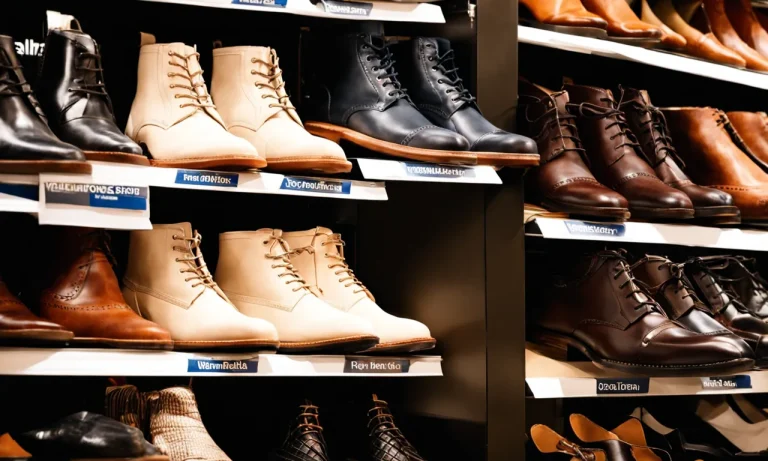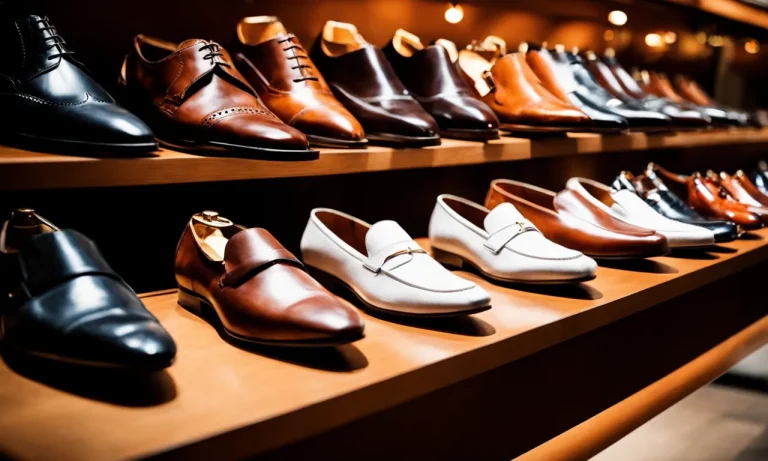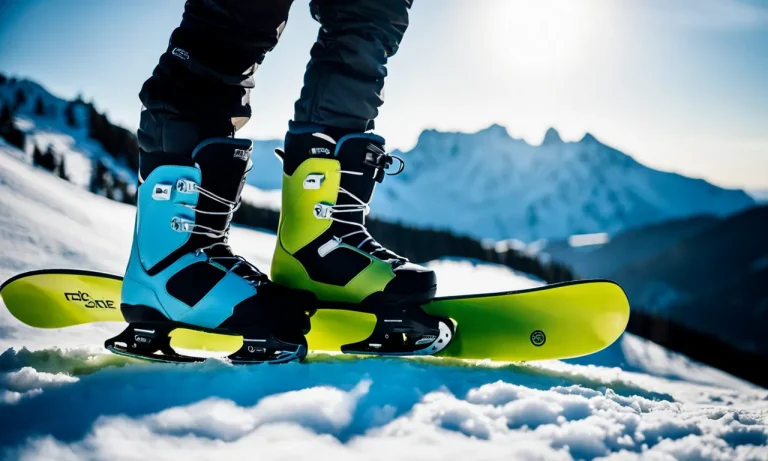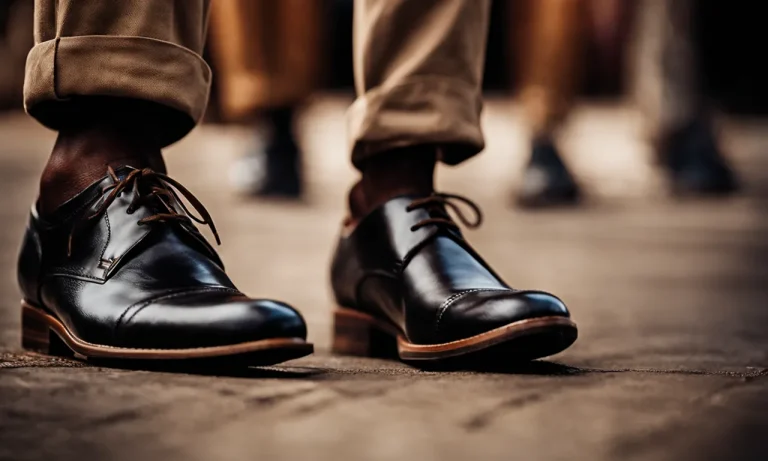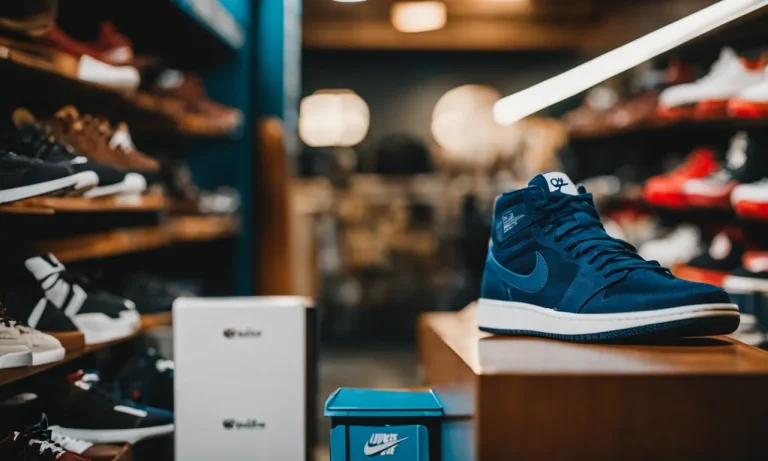Finding the perfect fitting shoe can be tricky. If your shoes are too small, they will pinch and rub and become very uncomfortable. However, shoes that are too big can also cause problems. Loose fitting shoes do not provide adequate support and can lead to foot pain, blisters, and even injuries if you trip.
So how do you know if a shoe is too big?
If you’re short on time, here’s a quick answer: look for excess room in the toe area, heel slippage when walking, and your foot sliding around inside the shoe. Read on below for more details on signs your shoes are too large and tips for finding the ideal fit.
Examine the Toe Area
When trying to determine if a shoe is too big, one of the first areas to examine is the toe area. Here are a few things to look for:
Wiggle Room at the Toes
One of the most important factors to consider is the amount of wiggle room you have at the toes. While it’s important for your toes to have some room to move, if there is excessive space, it might be an indication that the shoe is too big.
To check for this, press down on the top of the shoe near the toe area. If you can easily press down and feel excess space, it’s likely that the shoe is too big.
Pro tip: Remember that different shoe styles may have varying amounts of space at the toes. For example, running shoes typically have more room than dress shoes. Take this into account when evaluating the fit.
Observe While Standing and Walking
Another way to determine if a shoe is too big is to observe how it feels and looks while standing and walking. When standing, your toes should have enough space to lie flat and comfortably. If your toes are constantly curling or gripping the shoe, it could be a sign that the shoe is too big.
Similarly, pay attention to how the shoe fits when you walk. If you notice excessive slipping or sliding of your foot within the shoe, it could mean that it’s too big. Additionally, if you feel your heel lifting out of the back of the shoe with each step, that is another indication of a poor fit.
Fun fact: Did you know that wearing shoes that are too big can lead to foot problems like blisters and calluses? It’s important to find the right fit to avoid discomfort and potential foot issues.
Remember, finding the perfect fit for your shoes is essential for comfort and overall foot health. If you’re unsure about the fit, don’t hesitate to seek advice from a professional shoe fitter or podiatrist. They can provide expert guidance and recommendations based on your specific needs.
Check for Heel Slippage
One of the first signs that a shoe may be too big is heel slippage. When the shoe is too big, your heel may slide up and down while you are walking or running, causing discomfort and potentially leading to blisters. To check for heel slippage, you can perform a slide test and a walk test.
Slide Test
The slide test is a simple way to determine if your shoe is too big. Start by loosening the laces or straps on your shoe to create a snug fit around the foot. Then, with your foot in the shoe, try sliding your heel up and down.
If your heel easily slips out of the back of the shoe, it is a clear indication that the shoe is too big.
Walk Test
The walk test is another effective method to check for heel slippage and overall shoe fit. Put on the shoes and take a few steps, paying attention to how your feet feel. If your heel consistently lifts up with each step, it indicates that the shoe is too big.
On the other hand, if your foot feels secure and stable with minimal movement, it suggests a better fit.
It’s important to note that a small amount of heel slippage is normal in certain shoe types, such as high heels or dress shoes. However, in athletic shoes or everyday footwear, excessive heel slippage can lead to discomfort and potential foot problems.
If you find that your shoe is indeed too big and causing heel slippage, it’s recommended to try a smaller size or a different shoe model that provides a better fit. Remember, a properly fitting shoe is crucial for comfort, support, and overall foot health.
Evaluate the Fit Around Your Foot
One of the key indicators that a shoe is too big is if your feet slide around inside them. When trying on a pair of shoes, make sure to walk around and pay attention to how your feet feel. If they are constantly slipping and sliding, it is a clear sign that the shoes are too big for you.
This can be not only uncomfortable but also dangerous, as it increases the risk of tripping or twisting your ankle.
Do Your Feet Slide Around?
A good way to test if your feet are sliding around inside the shoes is to try walking on different surfaces. If you notice that your feet are constantly moving around and not staying firmly in place, it’s a strong indication that the shoes are too big.
You can also try jumping or running in the shoes to see if your feet stay securely in place. Remember, a properly fitting shoe should provide stability and support.
Is There Gapping at the Sides?
Another sign that the shoe is too big is if there is gapping at the sides. When you put on a shoe, check to see if there is any extra space between your foot and the shoe along the sides. If you can easily fit a finger or two between your foot and the shoe, it’s a clear indication that the shoe is too big.
A proper fitting shoe should hug your foot snugly without any significant gaps.
It is important to note that shoe sizes can vary between different brands and styles. Therefore, it’s always a good idea to try on shoes before making a purchase, even if you think you know your size. Additionally, consider getting your feet measured by a professional at a shoe store to ensure the most accurate fit.
Consider Sizing Down
One of the first things to consider when determining if a shoe is too big is to evaluate the sizing. If you find that your feet are slipping or sliding inside the shoe, it may be an indication that the shoe is too big for you.
It is important to note that shoe sizes can vary slightly between different brands and styles, so it’s always a good idea to try on the shoes before making a purchase.
Pay Attention to the Fit
When trying on a pair of shoes, pay attention to how they fit in different areas of your foot. If you notice that there is excess space around your toes or heels, it could be a sign that the shoes are too big.
Your toes should have enough room to wiggle comfortably, but not so much that they are sliding forward. Additionally, your heels should not be slipping out of the shoes when you walk.
Consider the Width
In addition to the length, it’s important to consider the width of the shoe. If you have narrow feet and notice that there is a significant amount of extra space on the sides of your feet, it could be an indication that the shoe is too wide for you.
Conversely, if you have wider feet and feel cramped or squeezed in the shoe, it may be too small.
Look for Signs of Wear
Another way to determine if a shoe is too big is to examine the wear patterns on the sole of the shoe. If you notice that the wear is primarily concentrated in certain areas, such as the heel or the ball of the foot, it could be a sign that the shoe is not fitting properly.
Uneven wear can indicate that your foot is not properly supported and may be sliding around inside the shoe.
It’s important to remember that everyone’s feet are unique, and what may be considered too big for one person may fit perfectly for another. If you’re unsure about the fit of a shoe, it’s always a good idea to seek advice from a professional shoe fitter or podiatrist.
They can provide valuable insights and recommendations based on your specific foot shape and needs.
For more information on finding the right shoe fit, you can visit websites such as Runner’s World or Verywell Fit.
Tips for Finding the Right Fit
Try Shoes On at the End of the Day
One important tip for finding the right fit is to try shoes on at the end of the day. Throughout the day, our feet can swell due to various factors such as walking or standing for long periods. By trying shoes on in the evening, when our feet are at their largest, you can ensure a better fit.
This is especially important when it comes to determining if a shoe is too big. If the shoe feels snug in the morning but too loose in the evening, it may be a sign that the shoe is too big.
Wear Socks
Another helpful tip is to always wear socks when trying on shoes. Socks not only provide added comfort but also take up some space inside the shoe. When trying on a shoe without socks, it may feel like the shoe fits perfectly, but once you wear it with socks, you may realize that it is actually too big.
Wearing socks while trying on shoes gives a more accurate representation of how the shoe will fit during regular use.
Have Both Feet Measured
Many people have slightly different-sized feet, with one foot being slightly larger than the other. To ensure a proper fit, it is recommended to have both feet measured when purchasing shoes. This way, you can purchase shoes that accommodate the larger foot without compromising the fit of the smaller foot.
The difference in size may be more noticeable when a shoe is too big, as there may be excess space in one shoe while the other fits correctly.
When it comes to finding the right fit for your shoes, it’s important to consider these tips. Trying shoes on at the end of the day, wearing socks, and having both feet measured can all contribute to a better fit and help you determine if a shoe is too big.
Remember, a well-fitted shoe is not only more comfortable but also better for your foot health in the long run.
Conclusion
Finding a properly fitted shoe is important for comfort and foot health. Pay attention to any excess room in the toe area, heel slippage when walking, and sliding of your foot inside the shoe. If you notice any of these signs, it likely means the shoes are too large.
Trying on at the end of the day, wearing socks, and having your feet sized can help you find the ideal fit. With the right shoe size, you can walk in comfort and style.

